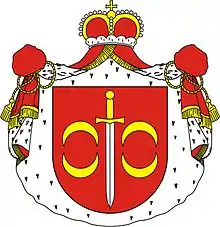Principality of Drutsk
The Duchy of Drutsk (Belarusian: Княства Друцкае) was a small appanage principality of the Polotsk principality and was centred in Drutsk.[1] It was located on a three way stick between Vitebsk, Minsk and Mogilev regions in modern Belarus.
| Duchy of Drutsk Князство Друцкое (Sla) | |||||||
|---|---|---|---|---|---|---|---|
| Appanage principality of Polotsk Principality | |||||||
| 1101–1565 | |||||||
 Coat of arms
| |||||||
| Capital | Drutsk | ||||||
| • Type | Feudal monarchy | ||||||
| History | |||||||
• Established | 1101 | ||||||
• Disestablished | 1565 | ||||||
| |||||||
| Today part of | Belarus | ||||||
The appanage duchy of Drutsk was established after the death of Vseslav, the Prince of Polotsk, in 1101 and the division of the Polatsk territory between Vseslav's sons. Drutsk was given to Rogvolod-Boris. Soon its territory was taken over by another appanage duchy of Polotsk, Duchy of Minsk governed by Gleb Vseslavich. In 1116, the duchy of Drutsk was taken over by the Grand Duchy of Kiev governed by Volodymyr Monomakh, but by 1150s it was returned to Duchy of Minsk. Eventually Drutsk was entirely taken over by the Principality of Minsk in the second half of the 13th century and in early 14th century by another appanage duchy of Polotsk, Principality of Vitebsk.
It is believed that Algirdas, Grand Duke of Lithuania, acquired the Duchy by marriage to Maria of Vitebsk. The Duchy became part of the Grand Duchy of Lithuania where it existed as an autonomous principality until an administrative reform in 1565–1566, when it was included into the Orsha county of Vitebsk Voivodeship.
Princes of Drutsk
- 1151-1158: Gleb of Drutsk, son of prince Rostislav of Minsk
- 1101-1119: Boris I of Polotzk, son of grand-prince Vseslav of Kiev
- 1140-1146: Rogvolod II of Polotzk, son of Boris I
- 1146-1151: Gleb of Drutsk, son of Rogvolod II
- from 1163: Gleb of Drutsk, son of Rogvolod II
- 1161-1171: Rogvolod II of Polotzk (again)
- until 1196: Boris of Drutsk, son of Gleb
- about 1217: Vojtech of Drutsk, son of prince Boris II of Polotzk
References
- Fennell, J. (2014). The Crisis of Medieval Russia 1200–1304. Longman History of Russia. Taylor & Francis. p. 17. ISBN 978-1-317-87314-3. Retrieved 14 September 2018.
.svg.png.webp)